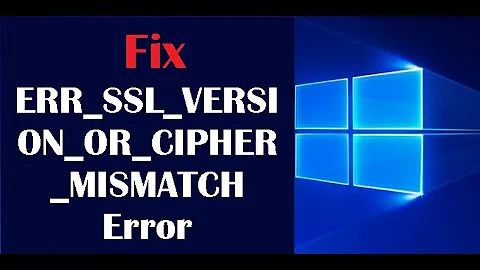Subject Alternative Name Missing & ERR_SSL_VERSION_OR_CIPHER_MISMATCH
Solution 1
I suggest the following solution: create self-signed CA certificate and the web server certificate signed by this CA. When you install this small chain to your web server it will work with Chrome.
Create configuration file for your CA MyCompanyCA.cnf with contents (you can change it to your needs):
[ req ]
distinguished_name = req_distinguished_name
x509_extensions = root_ca
[ req_distinguished_name ]
countryName = Country Name (2 letter code)
countryName_min = 2
countryName_max = 2
stateOrProvinceName = State or Province Name (full name)
localityName = Locality Name (eg, city)
0.organizationName = Organization Name (eg, company)
organizationalUnitName = Organizational Unit Name (eg, section)
commonName = Common Name (eg, fully qualified host name)
commonName_max = 64
emailAddress = Email Address
emailAddress_max = 64
[ root_ca ]
basicConstraints = critical, CA:true
Create the extensions configuration file MyCompanyLocalhost.ext for your web server certificate:
subjectAltName = @alt_names
extendedKeyUsage = serverAuth
[alt_names]
DNS.1 = localhost
DNS.2 = mypc.mycompany.com
Then execute the following commands:
openssl req -x509 -newkey rsa:2048 -out MyCompanyCA.cer -outform PEM -keyout MyCompanyCA.pvk -days 10000 -verbose -config MyCompanyCA.cnf -nodes -sha256 -subj "/CN=MyCompany CA"
openssl req -newkey rsa:2048 -keyout MyCompanyLocalhost.pvk -out MyCompanyLocalhost.req -subj /CN=localhost -sha256 -nodes
openssl x509 -req -CA MyCompanyCA.cer -CAkey MyCompanyCA.pvk -in MyCompanyLocalhost.req -out MyCompanyLocalhost.cer -days 10000 -extfile MyCompanyLocalhost.ext -sha256 -set_serial 0x1111
As result you will get MyCompanyCA.cer, MyCompanyLocalhost.cer and MyCompanyLocalhost.pvk files that you can install to the web server.
How to check that it works with Chrome before installing certificates to the web server. Execute the following command on your local PC to run web server simulator:
openssl s_server -accept 15000 -cert MyCompanyLocalhost.cer -key MyCompanyLocalhost.pvk -CAfile MyCompanyCA.cer -WWW
Then you can access this page at https://localhost:15000/ You will see an error that MyCompanyLocalhost.cer is not trusted, if you want to eliminate this error also - then install MyCompanyCA.cer to the certificate trusted list of your OS.
Solution 2
Thanks Oleg for nice solution. In my case, the URI is specified as an IP address rather than a hostname, finally, i get the solution from here.
I edit @Oleg's MyCompanyLocalhost.ext, from
subjectAltName = @alt_names
extendedKeyUsage = serverAuth
[alt_names]
DNS.1 = localhost
DNS.2 = mypc.mycompany.com
to
subjectAltName = @alt_names
extendedKeyUsage = serverAuth
[alt_names]
DNS.1 = domain.com
# IP address
IP.1 = 192.168.2.221
IP.2 = 127.0.0.1
Related videos on Youtube
SoftTimur
Updated on October 28, 2020Comments
-
SoftTimur over 3 years
I followed this answer to make
https://localhost:3000/work in Chrome & Mac. Today, it suddenly does not work anymore.https://localhost:3000givesNot Secure:Subject Alternative Name Missing The certificate for this site does not contain a Subject Alternative Name extension containing a domain name or IP address.I re-trusted this certificate by following the previous steps, which didn't help. Then I saw this answer, about remaking ssl keys.
So I made
v3.ext:authorityKeyIdentifier=keyid,issuer basicConstraints=CA:FALSE keyUsage = digitalSignature, nonRepudiation, keyEncipherment, dataEncipherment subjectAltName = @alt_names [alt_names] DNS.1 = localhostThen,
openssl req -x509 -newkey rsa:2048 -keyout key.pem -out cert.pem -days 365 -sha256 -extfile v3.extHowever, it returns
unknown option -extfile req [options] <infile >outfile where options are -inform arg input format - DER or PEM -outform arg output format - DER or PEM ... ...Does anyone know what's wrong with my
opensslcommand?Otherwise, does anyone know how to fix this
Subject Alternative Name MissingorNET::ERR_CERT_COMMON_NAME_INVALIDerror?Edit 1: I tried to follow this answer and here is my
example-com.conf:[ req ] default_bits = 2048 default_keyfile = server-key.pem distinguished_name = subject req_extensions = req_ext x509_extensions = x509_ext string_mask = utf8only # The Subject DN can be formed using X501 or RFC 4514 (see RFC 4519 for a description). # Its sort of a mashup. For example, RFC 4514 does not provide emailAddress. [ subject ] countryName = Country Name (2 letter code) countryName_default = US stateOrProvinceName = State or Province Name (full name) stateOrProvinceName_default = NY localityName = Locality Name (eg, city) localityName_default = New York organizationName = Organization Name (eg, company) organizationName_default = Example, LLC # Use a friendly name here because its presented to the user. The server's DNS # names are placed in Subject Alternate Names. Plus, DNS names here is deprecated # by both IETF and CA/Browser Forums. If you place a DNS name here, then you # must include the DNS name in the SAN too (otherwise, Chrome and others that # strictly follow the CA/Browser Baseline Requirements will fail). commonName = Common Name (e.g. server FQDN or YOUR name) commonName_default = Example Company emailAddress = Email Address emailAddress_default = [email protected] # Section x509_ext is used when generating a self-signed certificate. I.e., openssl req -x509 ... [ x509_ext ] subjectKeyIdentifier = hash authorityKeyIdentifier = keyid,issuer # You only need digitalSignature below. *If* you don't allow # RSA Key transport (i.e., you use ephemeral cipher suites), then # omit keyEncipherment because that's key transport. basicConstraints = CA:FALSE keyUsage = digitalSignature, keyEncipherment subjectAltName = @alternate_names nsComment = "OpenSSL Generated Certificate" # RFC 5280, Section 4.2.1.12 makes EKU optional # CA/Browser Baseline Requirements, Appendix (B)(3)(G) makes me confused # In either case, you probably only need serverAuth. # extendedKeyUsage = serverAuth, clientAuth # Section req_ext is used when generating a certificate signing request. I.e., openssl req ... [ req_ext ] subjectKeyIdentifier = hash basicConstraints = CA:FALSE keyUsage = digitalSignature, keyEncipherment subjectAltName = @alternate_names nsComment = "OpenSSL Generated Certificate" # RFC 5280, Section 4.2.1.12 makes EKU optional # CA/Browser Baseline Requirements, Appendix (B)(3)(G) makes me confused # In either case, you probably only need serverAuth. # extendedKeyUsage = serverAuth, clientAuth [ alternate_names ] DNS.1 = localhost # IPv4 localhost IP.1 = 127.0.0.1 # IPv6 localhost IP.2 = ::1Then, I did
openssl req -config example-com.conf -new -x509 -sha256 -newkey rsa:2048 -nodes -keyout example-com.key.pem -days 365 -out example-com.cert.pemReopen
https://localhost:3000in Chrome gives melocalhost uses an unsupported protocol. ERR_SSL_VERSION_OR_CIPHER_MISMATCHCan anyone help?
-
 EricLaw about 7 yearsI think stackoverflow.com/questions/10175812/… is what you're looking for; you'd use
EricLaw about 7 yearsI think stackoverflow.com/questions/10175812/… is what you're looking for; you'd use-configto pass in the file containing the configuration parameters. -
 jww about 7 yearsStack Overflow is a site for programming and development questions. This question appears to be off-topic because it is not about programming or development. See What topics can I ask about here in the Help Center. Perhaps Super User or Unix & Linux Stack Exchange would be a better place to ask. Also see Where do I post questions about Dev Ops?
jww about 7 yearsStack Overflow is a site for programming and development questions. This question appears to be off-topic because it is not about programming or development. See What topics can I ask about here in the Help Center. Perhaps Super User or Unix & Linux Stack Exchange would be a better place to ask. Also see Where do I post questions about Dev Ops? -
SoftTimur about 7 yearsPlease see my Edit 1, I have got a
ERR_SSL_VERSION_OR_CIPHER_MISMATCHerror...
-
-
SoftTimur almost 7 yearsWow, it works... thank you! For the record, after generating those files, I changed in my
wwwtovar config = { key: fs.readFileSync('ssl/MyCompanyLocalhost.pvk'), cert: fs.readFileSync('ssl/MyCompanyLocalhost.cer') }. Chrome first gaveERR_CERT_AUTHORITY_INVALIDerror, then I added that certificate tologinbyKeychain Access, it worked! -
 dsaket over 6 yearsWoahhh..I did as you suggested and it worked like a charm after I struggled for almost 5 hours!!
dsaket over 6 yearsWoahhh..I did as you suggested and it worked like a charm after I struggled for almost 5 hours!! -
 bwoogie over 6 yearsThanks for this! A couple hours wasted searching for an answer, but this did it!
bwoogie over 6 yearsThanks for this! A couple hours wasted searching for an answer, but this did it! -
Mel Lota over 6 yearsWish I could upvote this a million times, this is the only solution that worked for me
-
 petrosmm about 6 yearsI can confirm this works with the latest Chrome 65 on OSX.
petrosmm about 6 yearsI can confirm this works with the latest Chrome 65 on OSX. -
 Dmitry Efimenko over 5 yearson Windows use two slashes in these cases: (1)
Dmitry Efimenko over 5 yearson Windows use two slashes in these cases: (1)-subj "/CN=MyCompany CA", (2)-subj /CN=localhost. So it'd be: (1)-subj "//CN=MyCompany CA", and (2)-subj //CN=localhost -
Kyle McDonald about 5 yearsI made this answer into something that is a little easier to copy-paste, and added an example of using it with a local web server gist.github.com/kylemcdonald/429a3ad34981d3ed6fc539f6166b578e
-
JMags1632 over 3 yearsThis helped me when I encountered the issue "Subject Alternative Name Missing" regarding my previous certificate when using MAMP. For me, I just added the ff. on httpd-ssl.conf: myCompanyLocalhost.cer path to SSLCertificateFile, and myCompanyLocalhost.pvk after following the above instructions and then just restart MAMP. Worked like a charm!
![[SOLVED] ERR_SSL_VERSION_OR_CIPHER_MISMATCH Error Code](https://i.ytimg.com/vi/VZmVOuQvRpU/hq720.jpg?sqp=-oaymwEcCNAFEJQDSFXyq4qpAw4IARUAAIhCGAFwAcABBg==&rs=AOn4CLDSmvK64k6ODq-4808jXqd-LMYgUQ)






